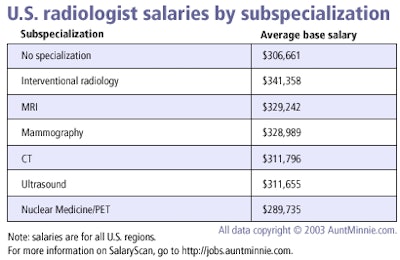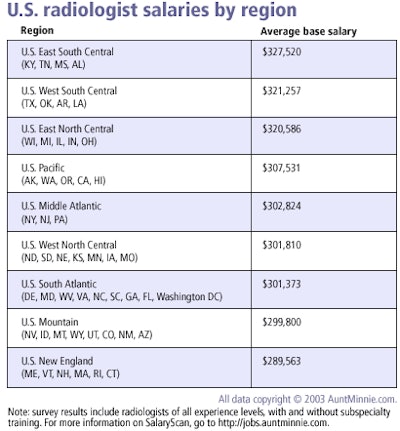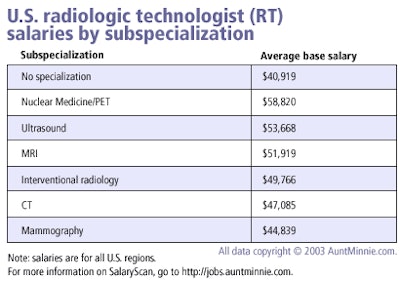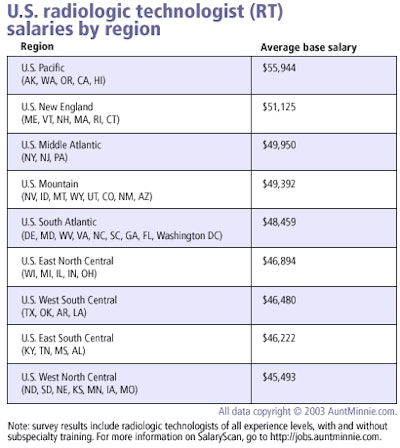
Acquiring subspecialized expertise pays big dividends for radiology professionals, according to the latest data from a new compensation survey published by AuntMinnie.com and healthcare recruiting firm CompHealth. Adding a subspecialization to one’s credentials can boost incomes by tens of thousands of dollars for some professions, according to the data.
AuntMinnie’s CompHealth SalaryScan survey collected data from over 4,500 radiology professionals in a six-week period between December 2002 and January 2003. It covered 15 job categories and received participation from radiology professionals all over the world.
The survey found that U.S. radiologists with no specialization who responded to the survey earned an average base salary of $306,661 and a median salary of $280,000. Adding subspecialization training in MRI, however, boosted the average base salary by 7.4%, to $329,242. Subspecialty expertise in CT had less of an impact, however: the average base salary of a radiologist with CT subspecialty expertise was $311,796, an increase of just 1.7% over those who reported no subspecialization.
 |
Interventional radiologists saw the biggest growth in salary thanks to added credentials and expertise: their average base salary was $341,358, up 11.3% compared to U.S. radiologists without subspecialization, according to the SalaryScan results.
Regional differences
As in the 2002 SalaryScan, respondents to this year’s survey indicated sharp differences in pay scales in different regions.
The U.S. region with the highest salaries was the U.S. East South Central region, encompassing the states of Kentucky, Tennessee, Mississippi, and Alabama. Radiologists in this zone -- with and without subspecialization training -- made an average base salary of $327,520 and a median salary of $300,000, according to SalaryScan data.
At the low end of the radiologist salary spectrum was the U.S. New England region, including the states of Maine, Vermont, New Hampshire, Massachusetts, Rhode Island, and Connecticut. New England radiologists -- with and without subspecialization training -- reported an average base salary of $289,563 and a median salary of $257,000.
 |
Sample SalaryScan results for radiologists from around the world include the following:
- Canadian radiologists, average base salary of $209,167 (in U.S. dollars).
- Australian and New Zealand radiologists, $153,763.
- Western European radiologists, $125,326.
- Northern European radiologists, $91,667.
Technologist results
Radiologic technologists without subspecialized expertise reported an average base salary of $40,919 and a median salary of $39,000. Adding subspecialization training in nuclear medicine/PET boosted the average base salary to $58,820, an increase of 43.7%. RTs with subspecialty training in MRI saw their average base salary grow 26.9%, to $51,919.
 |
As in last year’s survey, the most lucrative regions for RTs were not the same as those for radiologists. RTs in the U.S. Pacific region (Alaska, Washington, Oregon, California, and Hawaii) were the best compensated, with an average base salary of $55,944. RTs in the U.S. West North Central zone had the lowest average base salary, at $45,493.
 |
Meanwhile, U.S. radiology administrators turned in an average base salary of $75,712. Professionals in the hotly watched PACS/RIS manager category reported an average base salary of $60,668.
AuntMinnie members can conduct searches on comparable salaries in their professions by going to the SalaryScan database query tool on AuntMinnie’s Job Boards home page, at http://jobs.auntminnie.com.
AuntMinnie.com staff writer
March 13, 2002
Related Reading
Salary survey: U.S. radiologists make hay in southern states, June 10, 2002
Copyright © 2003 AuntMinnie.com



















